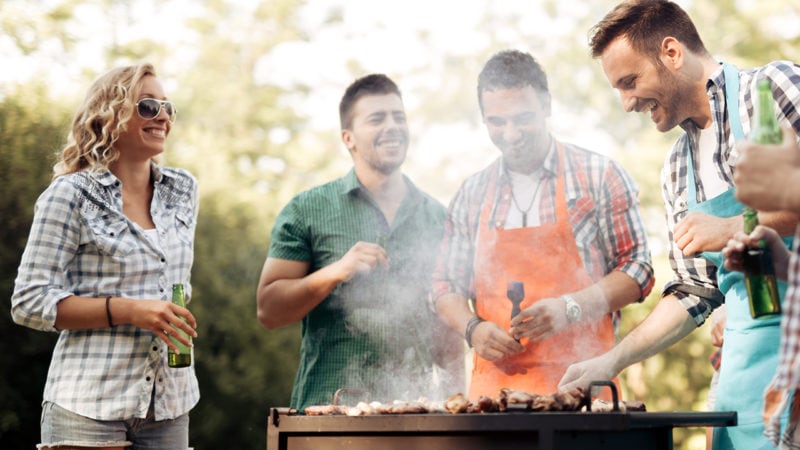Last Updated on January 27, 2025
Backyard barbecues with speakers blaring, friends laughing, and sizzling burgers on the grill. Breezy beach days with fizzy drinks, cold sandwiches, and lots of sun tan lotion. Park hangs with picnic baskets, bottles of bubbly, and containers of tasty prepared snacks. No matter your ideal summer scenario, there’s always one common theme that truly gets people together: good weather and good food. And nothing can be more of a buzzkill than food that has gone bad—especially if that includes a shipment of ButcherBox proteins.
As you dust off your beach chairs and sweep your back patio, make sure you brush up on summer cooking safety. From keeping your guests safe, keeping your food safe, and keeping yourself safe, there are a lot of details to keep in mind so everything for your cookout goes smoothly. But unless it’s a hot summer day, you don’t have to sweat it; we here at ButcherBox put together a summer cooking safety guide that walks you through a step-by-step process so you don’t have to worry about any of those little details and focus on what matters most—having fun!
Put the grill in the shade.
When choosing where to grill outside, be sure to find a spot that is shady and away from direct sunlight—especially if you plan on grilling on a hot day. “This helps keep the grill—and the chef—from overheating,” says Sebastian DiFelice, owner and pitmaster at The Don’s BBQ.
Pest control the area first.
The last thing you want to deal with is unwanted pests in your cooking and eating area, so DiFelice suggests treating your cookout area with a pest control product at least 30 minutes before you start cooking. “This keeps unwanted guests out of your cooking area and reduces distractions,” he says.
Clean the grill to prevent grease build-up.
“The worst nightmare of grilling outdoors is food getting stuck on the grates and being unable to prevent the risk of flare-ups,” says Advika Menon, recipe developer and founder of My Spice. “To ignore these problems make sure to keep the grill clean and free of grease buildup.”
To ensure this nightmare doesn’t become a reality, make sure to clean and prep the grill before getting started. This means tossing leftover charcoal, cleaning off cooking residue and ash, and spraying it down with a degreaser.
Separate your proteins and other foods.
When prepping your food to get ready for the grill, make sure you aren’t cross-contaminating your proteins and other food products when it comes to the different supplies you use.
“Keep separate cutting boards for different types of food,” says Chef Devon Ferguson, senior editor at Carnivore Style. “Use separate cutting boards for meats, vegetables, and fruits to prevent cross-contamination.”
DiFelice also suggests using separate coolers when you bring the foods outside, as to ensure that the uncooked foods are kept separate. “Use one cooler and set of utensils for meats & seafood and one set for veggies,” he says. “I even use a separate cooler for condiments too. No one wants runny hot ketchup, and it keeps them from getting lost or forgotten.”
Make sure the grill is at temperature first.
When it’s time to finally get the grill going, be patient before adding any of your foods to the grill, as to ensure the grill is always at the right temperature and you don’t undercook your food.
“Those built-in gauges often stop working, so I recommend grabbing one you can snap on inside your grill for accuracy,” says DiFelice.
Have cleaning supplies on hand.
“Outdoor cooking can get messy! Bugs, sand, accidental drops, and more,” says DiFelice.
His suggestion—whether you’re cooking at home or bringing your grilling supplies to a park or beach—is to have a jug of cleaning solution on hand when things get messy.
“Grab a gallon jug, fill it with water, drop in one tablespoon of bleach, and shake well. Use as needed to wipe things off,” he says. “I like to put some in a container, soak a cloth, and keep it near my cooking area to wipe down messes and keep things sanitary.”
Make sure meat is properly thawed before cooking.
If you plan on cooking up ButcherBox meat you’ve been saving in the freezer, make sure that it’s thoroughly thawed before tossing it onto the grill. Nicole Ibarra, RD, says that you’ll want to thaw the meat in the fridge fully before preparing it to cook. To ensure your meat or seafood is thoroughly defrosted, place it in the fridge at least 24 hours before you plan on cooking it so it has time to thaw, while still remaining at a safe cool temperature.
When it’s time to cook the protein, Ibarra suggests covering your protein source with aluminum foil on a plate to help keep the meat cool for a little while longer. “This will reflect the light and reduce the sunlight and heat on your food to reduce the chance of your food getting into the danger zone where food can start to grow bacteria,” she says.
Check the food for spoilage.
Even before tossing those steaks on the grill, you want to make sure your proteins are still in tip-top shape for cooking—meaning they haven’t gone bad, which could increase the risk of someone getting sick. “Before using the food items before cooking, also check if any signs of spoilage are visible, such as odor or slimy texture,” says Menon. “This can help you suspect that food is spoiled. If you’re quite unsure if the food is safe to eat or not, it’s better to discard it.”
An easy rule of thumb to remember from the Food Safety guidelines is to not let ground meats sit in the fridge for more than two days, and other cuts of meat up to five days. So if your ButcherBox delivery came days before you plan on hosting a cookout, it may be best to freeze your meats to be safe, then thaw them 24 hours before your gathering.
Keep washing your hands
“Wash your hands thoroughly for at least 20 seconds with soap and warm water, before and after handling food,” says Menon. “It is important to maintain proper hygiene when you’re outdoors or at a campsite where hand washing facilities may be limited.”
While it seems tedious, keeping your hands clean at all times is key to ensuring that everything is clean and cooked safely. “This is the simplest and most effective way to prevent the spread of bacteria and germs,” says Chef Devon Ferguson, senior editor at Carnivore Style. “Before and after handling food, after using the restroom, and after touching any potentially contaminated surfaces.”
Have a thermometer on hand.
Now that you have your ButcherBox meat ready to go, and the grill has sufficiently been preheated, it’s time to start grilling. Just make sure you have the right utensils on hand—especially a thermometer. Not only to ensure that your meat is fully and safely cooked, but also to make sure you’re not overcooking it. Because no one likes an overdone steak or burger.
“Overcooking the meat can also destroy the taste and texture of the meat,” says Menon. “To prevent this, it is recommended by the USDA to use a thermometer to ensure that your meat is cooked to a safe temperature. Kindly cook the beef, pork, lamb, and veal to an internal temperature of 145 degrees Fahrenheit, ground meats to 160 degrees, and poultry to 165 degrees.
Have serving containers and utensils ready to go.
Along with a thermometer, you’ll want to have serving containers and utensils ready for when the food is cooked. The last thing you want to do is run for some kind of serving tray, causing you to leave a hot grill alone and potentially overcooking your delicious ButcherBox protein.
If you’re cooking in a park or a beach away from your usual setup and find your tray options to be limited, DiFelice says this is where having your cleaning solution comes in handy. He will wipe down the trays that held his uncooked meat using his cleaning cloth, then wrap up the tray with aluminum foil to give it another layer of protection.
As for serving, he says tongs are his go-to utensil for their versatility in serving any kind of food.
Don’t leave food out for too long.
“Leaving food out at room temperature or in the sun for a short time can increase the risk of bacterial growth and food-borne illness,” says Menon. “Avoid leaving food out for more than two hours in the summer or one hour if the temperature is above 90 degrees.”
Store your food properly.
“When you’re outdoors, it’s important to keep hot foods hot and cold foods cold to prevent bacteria growth,” says Ferguson. “Use insulated containers and ice packs to maintain safe temperatures.”
Food Safety guidelines recommend keeping cold foods in an environment below 40 degrees, and hot foods at 140 degrees. “Perishable food items like veggies, salads, meat, and dairy products should be kept in the cooler until you’re ready to make a meal,” says Menon.
Don’t forget to drink water.
Now that you’ve sufficiently taken care of the safety of your food and your guests, it’s also important to focus on the safety of yourself. As in, don’t forget to drink lots of water if you’re grilling on a hot day!
Kiersten Hickman is a freelance journalist and content strategist, covering a variety of topics in the food, health, and lifestyle categories. Her work has been published by Reader's Digest, Taste of Home, Clean Plates, EatingWell, Eat This, Not That!, Bustle, Stacker, The Everygirl, and more. She also writes Forkful, a weekly essay on Substack debunking diet culture myths, and is in the process of publishing her first novel.



